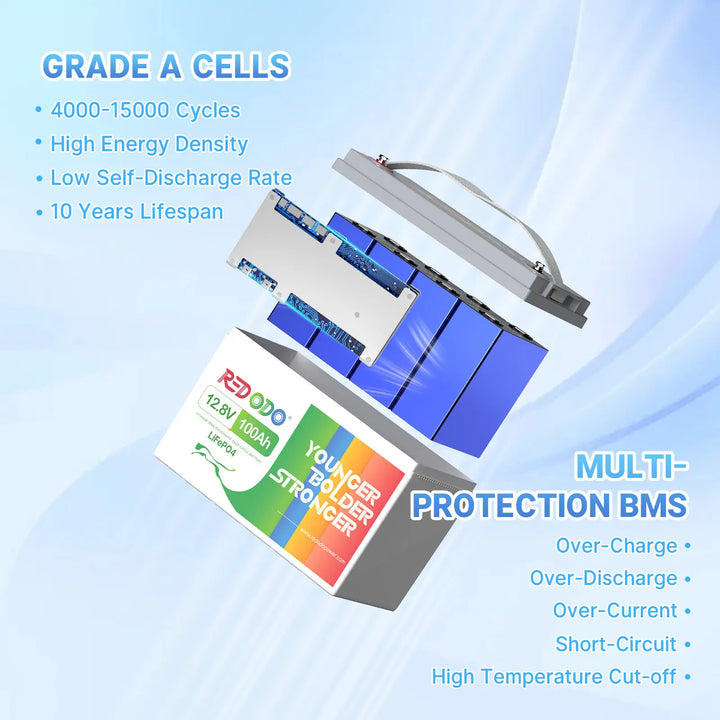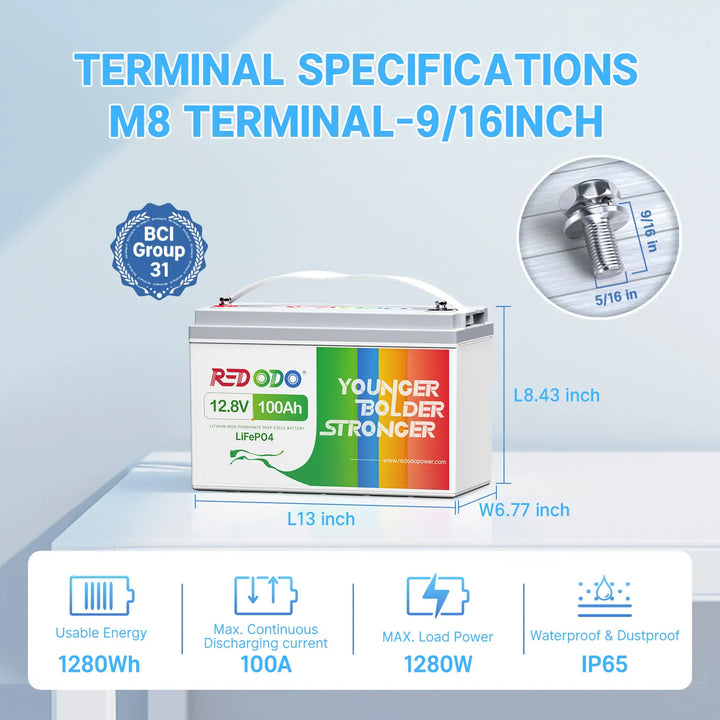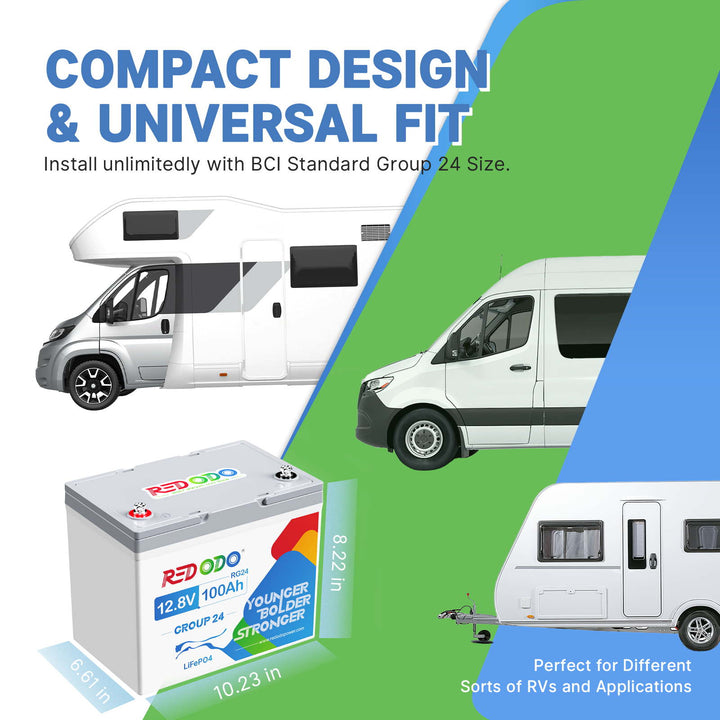Known for their high cranking amps and reserve capacity, Group 27 batteries are designed to provide reliable starting power and long-lasting performance. They are commonly used in marine, RV, and automotive applications, as well as in off-grid solar power systems and other industrial uses. In this article, we'll explore the dimensions, features, and applications of Group 27 batteries, helping you determine the right choice for your needs.
Table of Content
What is A Group 27 Battery?
A Group 27 battery is a standardized type of battery that follows specific size and performance specifications set by the Battery Council International (BCI). Group 27 batteries are typically larger than Group 24 batteries but smaller than Group 31, making them an excellent mid-range option in terms of both size and power.
Group 27 Battery Dimensions
The dimensions of a Group 27 battery are standardized, but slight variations may exist depending on the manufacturer and battery type (lead-acid vs. lithium). Understanding the dimensions is essential for ensuring that the battery fits correctly within the designated battery compartment.
Typically, Group 27 batteries feature physical dimensions of 12.0625 x 6.8125 x 8.875 inches (306 x 173 x 225 mm). Additionally, here are the dimensions of Group 27F and 27H batteries:

These dimensions make the Group 27 battery larger than Group 24 batteries but smaller than Group 31 batteries. The size provides a balance between capacity and portability, making it suitable for various applications.
Read More: Group 24 VS Group 31 Deep Cycle Batteries
Group 31 Batteries Dimension & Features
Group 27 Battery Weight
The weight of a Group 27 battery can vary significantly based on its construction and chemistry. Here’s a breakdown of common battery types and their typical weights:
- Lead-Acid Group 27 Battery Weight: Between 50 and 60 lbs (22.7 to 27.2 kg)
- AGM (Absorbed Glass Mat) Group 27 Battery Weight: Typically 60 to 70 lbs (27.2 to 31.8 kg)
- Lithium-Ion Group 27 Battery Weight: Much lighter, typically around 25 to 30 lbs (11.3 to 13.6 kg)
Lead-acid batteries are generally heavier than their lithium counterparts. The lighter weight of lithium Group 27 batteries makes them an attractive option for applications where reducing weight is essential, such as in RVs and boats.
Most Group 27 batteries are lead-acid AGM batteries. Lithium Group 27 batteries are not as common as lithium Group 31 batteries. If you are looking for a 12V 100Ah deep cycle battery or similar Group 27 battery, Check out Redodo 12V 100Ah Deep Cycle LiFePO4 battery.
Features of Group 27 Battery
Group 27 batteries come with a range of features that make them versatile and reliable. Here are some of the key features to consider:
- High Capacity
Group 27 batteries typically offer a higher capacity compared to smaller groups. This means they can store more energy, providing longer runtimes for your devices or vehicles. The capacity is often measured in ampere-hours (Ah), with typical ratings ranging from 85Ah to 100Ah for lead-acid batteries and 100Ah for lithium batteries.
- Deep Cycle Capability
Many Group 27 batteries are designed as deep cycle batteries, meaning they can be discharged and recharged repeatedly without significant degradation. This makes them ideal for applications like trolling motors, RVs, and solar energy systems where consistent power is needed over extended periods.
- Starting Power
Group 27 batteries are also available in dual-purpose designs that combine deep cycling with high cold-cranking amps (CCA) for starting engines. This makes them suitable for use in boats and other vehicles where both starting power and sustained energy supply are required.
- Maintenance-Free Options
Modern Group 27 lithium batteries often come with maintenance-free designs. This means they don’t require regular topping up of water levels, making them more convenient for users who prefer minimal upkeep.
- Advanced Safety Features
Many Group 27 lithium batteries include built-in Battery Management Systems (BMS). These systems help prevent overcharging, overheating, and short-circuiting, enhancing the safety and longevity of the battery. Redodo LiFePO4 batteries are equipped with advanced BMS, offering 20+ protections to ensure battery safety and extend battery life.

Applications of Group 27 Batteries
The versatility of Group 27 batteries makes them suitable for a wide range of applications.
Group 27 batteries are a popular choice in the marine industry, particularly for boats with trolling motors, navigation systems, and other electrical equipment. The deep cycle capabilities ensure reliable power over long periods, making them ideal for fishing trips or long voyages.
RVs often rely on Group 27 batteries to power onboard appliances, lights, and other systems. The high capacity and deep cycle nature of these batteries ensure that RV owners have a dependable power source for extended camping trips, even in off-grid locations.
- Solar and Off-Grid Systems
Off-grid and solar power systems often incorporate Group 27 batteries to store generated energy. Their high capacity and long life make them a reliable choice for people living off the grid or in remote locations, helping to maintain a steady power supply even when the sun isn’t shining.
- Backup Power Systems
In situations where uninterrupted power is critical, such as in hospitals, data centers, or telecommunications, Group 27 batteries serve as reliable backup power sources. Their high capacity ensures that essential systems remain operational during power outages.
- Automotive Use
While not as common as Group 24 or Group 31 batteries in cars and trucks, Group 27 batteries are sometimes used in larger vehicles or trucks where higher power is needed.
- Industrial Equipment
Group 27 batteries are also used in various industrial applications, including forklifts and other equipment that requires robust and reliable power. The durability and capacity of these batteries make them well-suited for demanding industrial environments.
How To Choose the Right Group 27 Battery
When selecting a Group 27 battery, several factors should be considered to ensure you choose the right one for your specific needs:
Battery Type
Decide between lead-acid and lithium batteries based on your application and budget. Consider whether you need a traditional and more popular option like AGM battery, or if you prefer the extended lifespan and lighter weight of modern lithium-ion battery.
Capacity
Consider the ampere-hour (Ah) rating of the battery to ensure it meets your energy needs. Group 27 batteries typically have a capacity range between 85 to 105 Ah. For applications requiring sustained power over long periods, a higher capacity battery may be necessary.
Physical Dimensions
Ensure that the battery will fit within the available space in your vehicle or equipment. While Group 27 dimensions are standardized, it’s always a good idea to double-check the measurements.
Consider the Group 24 battery as a replacement for the Group 27 battery. Its dimension slightly smaller than the Group 27, so you won’t need to worry about it fitting into your existing battery box. The Redodo Group 24 Battery offers similar performance and can be a suitable alternative for applications where space is limited or a more compact battery is desired.
Weight
If weight is a concern, such as in marine or RV applications, a lithium Group 27 battery may be the best choice due to its lighter weight. The lighter weight of lithium batteries not only makes installation and handling easier but can also contribute to better fuel efficiency and overall performance in mobile applications.
Budget
Lead-acid Group 27 batteries are generally more affordable upfront, making them a cost-effective choice for users with immediate budget constraints. However, they tend to have a shorter lifespan, usually lasting 3 to 5 years, and require regular maintenance to perform optimally. In contrast, lithium-ion Group 27 batteries have a higher initial cost but offer significant long-term benefits due to their longer lifespan of 10 years and maintenance-free requirements.
FAQs on Group 27 Battery
1. What is the difference between Group 24 and Group 27?
The primary differences between Group 24 and Group 27 batteries lie in their size, capacity, and weight. Group 27 batteries are generally larger, with dimensions of approximately 12.06 x 6.81 x 8.87 inches, while Group 24 batteries are slightly smaller, typically measuring around 10.25 x 6.81 x 8.87 inches. Additionally, Group 27 batteries tend to weigh more than Group 24 batteries due to their larger size and greater capacity.
2. Can I replace a Group 27 battery with a Group 24?
Yes, you can replace a Group 27 battery with a Group 24 battery. you might consider choosing a Group 24 battery if space is limited in your application or if you require a slightly lighter battery. While Group 27 batteries provide more power and longer runtimes, Group 24 batteries can be a suitable alternative for applications with lower power requirements or where weight and size are more critical considerations. The Redodo Group 24 Battery offers a capacity of 100Ah, which matches the typical capacity of a Group 27 battery. This makes it a perfect alternative for those seeking the performance of a Group 27 battery.
3. Can I replace a Group 27 battery with a Group 31 battery?
Yes, you can replace a Group 27 battery with a Group 31 battery, but there are a few considerations to keep in mind. Group 31 batteries are slightly larger and heavier than Group 27 batteries, so you’ll need to ensure that your battery compartment has enough space to accommodate the larger size. The Redodo Group 31 Battery features dimensions of 13 x 6.77 x 8.5 inches and weighs just 22.84 lbs, making it lighter than other batteries on the market. Additionally, it is equipped with Bluetooth function for easy monitoring of battery status and performance.
4. Can I mix Group 24 and Group 27 batteries?
Mixing Group 24 and Group 27 batteries in the same system is generally not recommended. This is because the differences in capacity, size, and performance can lead to imbalances in the system. If you must mix different battery sizes, ensure that they are of the same type and have the same voltage. It's also crucial to monitor the system closely to avoid overcharging or over-discharging one battery. However, for optimal performance and longevity, it’s best to use batteries of the same group size and capacity.
Conclusion
Group 27 batteries offer a versatile and reliable power solution for a wide range of applications, from marine and RV use to industrial equipment and solar energy systems. By understanding the dimensions, features, and applications of these batteries, you can make an informed decision that meets your power needs. Whether you prioritize high capacity, deep cycle capability, lightweight design, or value cost, the lithium Group 27 battery is a dependable choice for various demanding environments.

Redodo

Redodo
Recent Post

How Long Will a 200Ah Battery Run an Air Conditioner?

A Full Review of Redodo 12V 140Ah Group 31 Deep Cycle Battery

How Much Does it Cost to Replace Golf Cart Batteries?

What Size Fish Finder Battery Do I Need? 2025 Updated



![⚡[$167 after Sign-Up] Redodo 12V 100Ah Group 24 Deep Cycle LiFePO4 Lithium Battery | 20% Smaller | For Home, RV, Marine](http://www.redodopower.com/cdn/shop/files/group_24_3255e3e9-409d-412d-8871-4f05861a5c1e.jpg?v=1742968223)
![⚡[$190 after Sign-Up] Redodo 12V 100Ah Group 24 Bluetooth LiFePO4 Battery | Real-Time Battery Monitoring | For RV, Marine, Solar](http://www.redodopower.com/cdn/shop/files/group_24_BT_312a5c81-ec74-4307-a7f5-c05e195d5246.jpg?v=1742971855)
![⚡[$190 after Sign-Up] Redodo 12V 100Ah Group 31 Bluetooth Lithium Battery | Real-Time Battery Monitoring | For RV, Marine, Solar](http://www.redodopower.com/cdn/shop/files/GROUP_31_0501cb0c-ed50-4c4a-b78e-b7ab501d90b4.jpg?v=1742971970)
![⚡[$246 after Sign-Up] Redodo 12V 140Ah Group 31 Lithium Battery with Bluetooth | 40% More Capacity | For RV, Marine, Solar Home](http://www.redodopower.com/cdn/shop/files/Redodo_12V_140ah_bluetooth_battery_ee6d5fd1-5c7d-4b9a-90ab-d54d06b29a04.jpg?v=1742967763)


![⚡[$171 after Sign-Up] Redodo 12V 100Ah LiFePO4 Lithium Battery | Best Budget | For RV, Solar, Trolling Motor](http://www.redodopower.com/cdn/shop/files/Redodo_12v_100ah_lithium_battery_b9015ddd-64b5-4be2-8c88-392f0bb4ab30.jpg?v=1742973160)
![⚡[$171 after Sign-Up] Redodo 12V 100Ah Lithium Trolling Motor Battery With Low Temp Protection](http://www.redodopower.com/cdn/shop/files/Redodo12V100Ahlow-tempbattery.webp?v=1738462317)
![⚡[$205 after Sign-Up] Redodo 12V 100Ah Mini Lithium LiFePO4 Battery | Smallest Battery | For RV, Trolling Motor, Solar](http://www.redodopower.com/cdn/shop/files/Redodo12V100AhMiniLiFePO4LithiumBattery.jpg?v=1739959054)